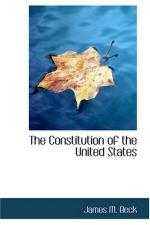A national executive was proposed, together with a national judiciary, and these two bodies were given authority “to examine every act of the national legislature before it shall operate and every act of a particular legislature before a negative thereon shall be final.” This marked an immense advance over the Articles of Confederation, under which there was no national executive or judiciary, and under which the legislature had no direct power over the citizens of the States, and could only impose duties upon the States themselves by the concurrence of nine of the thirteen.
Hardly had Mr. Randolph submitted the so-called Virginia plan when Charles Pinckney, of South Carolina, a young man of twenty-nine years of age, with the courage of youth submitted to the House a draft of the future federal government. Curiously enough, it did not differ in principle from the Virginia plan, but was more specific and concrete in stating the powers which the federal government should exercise, and many of its provisions were embodied in the final draft. Indeed, Pinckney’s plan was the future Constitution of the United States in embryo; and when it is read and contrasted with the document which has so justly won the acclaim of men throughout the world, it is amazing that so young a man should have anticipated and reduced to a concrete and effective form many of the most novel features of the Federal Government. As the only copy of Pinckney’s plan was furnished years afterwards to Madison for his journal, it is possible that some of its wisdom was of the post factum variety.
Having received the two plans, the convention then went, on May 30, into a committee of the whole to consider the fifteen propositions in the Virginia plan seriatim. They wisely concluded to determine abstract ideas first and concrete forms later. Apparently for the time being little attention was paid to Pinckney’s plan, and this may have been due to the hostile attitude of the older members of the convention to the presumption of his youth.
Then ensued a very remarkable debate on the immediate propositions and the principles of government which underlay them, which lasted for two weeks. On June 13 the committee rose. Even the fragments of this debate, which may well have been one of the most notable in history, indicate the care with which the members had studied governments of ancient and modern times. There were many points of difference, but chief of them, which nearly resulted in the collapse of the convention, was the inevitable difficulty which always arises in the formation of a league of States or an association of nations between the great and the little States.




